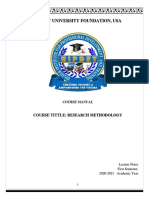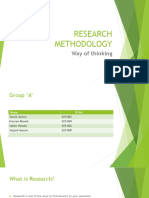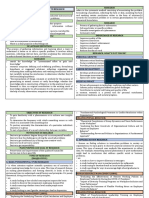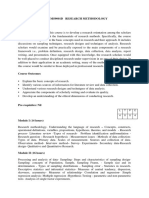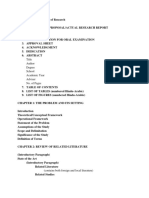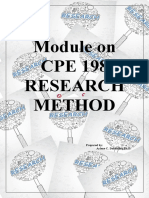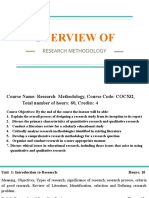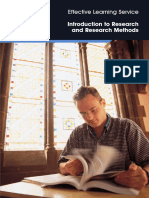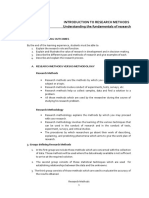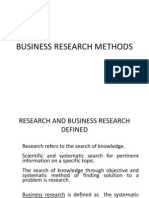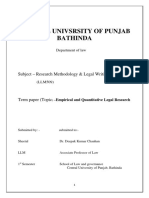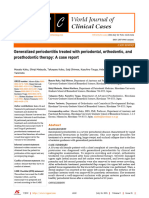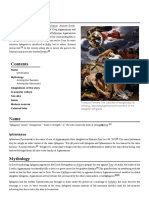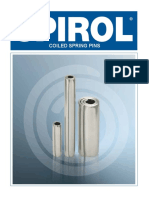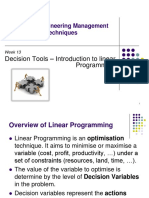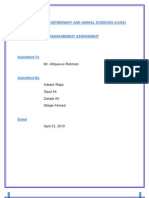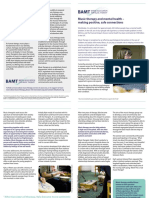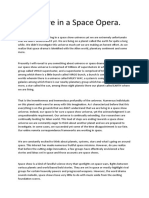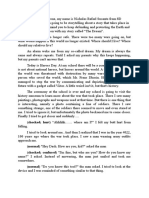RAJENDRA PRASAD LAW INSTITUTE , NAINITAL
TYPES OF RESEARCH
SESSION 2024-2025
SUBJECT – RESEARCH METHODOLOGY
SUBMITTED TO SUBMITTED BY
SWATI ARYA
LLM II SEM
ROLL NO- 2240125790033
ENROLLMENT NO- KU19109440
� RESEARCH METHODOLOGY LLM II
ACKNOWLEDGEMENT
I would like to express my sincere gratitude to everyone who has
helped and supported me in completing this assignment.
First and foremost, I would like to thank my teacher for their valuable
guidance, constant encouragement, and support throughout the
project. Their insights and suggestions were immensely helpful.
Lastly, I appreciate all those who directly or indirectly contributed to
this project. Their help has been deeply appreciated.
Thank you all for your invaluable support.
1
� RESEARCH METHODOLOGY LLM II
CONTENTS
S. NO TOPIC
1 Introduction
2 Legal Framework for Children’s Education in India
• Constitutional Provisions
• Legislative Framework
3 Judicial Approach: Landmark Cases
4 Government Policies and Initiatives
6 Role of Education in Social Transformation
7 Challenges in Implementing Education Laws
9 Recommendations for Strengthening the Legal Framework
10 Conclusion
11 Biblography
2
� RESEARCH METHODOLOGY LLM II
INTrODuCTION
There are various established methods used in research to
investigate a problem or research in question.
It plays a vital role for the researchers to prove the hypothesis based
on clearly defined parameters, environments and assumptions.
Understanding and having a deep knowledge about the types of
research can help the researchers to better plan the project by
utilizing the most appropriate methodologies and techniques.
Types of Research
Applied Research
Basic Research
Correlational Research
Descriptive Research
Ethnographic Research
Experimental Research
Exploratory Research
Grounded Theory
Historical Research
Phenomenological Research
Qualitative Research
Quantitative Research
3
� RESEARCH METHODOLOGY LLM II
1. Applied Research
It is a scientific study that seek to solve various practical
problems in the day to day life.
It find answers or solutions to everyday problems, cure
illness, develop innovative technologies etc.
Applied research aims at finding solutions to specific real-
world problems. It uses principles derived from basic
research to develop practical applications
For example-
1. Improve agricultural crop production
2. Treat or cure specific disease
3. Improve energy efficiency of homes, offices, modes of
transportation
Characteristics:
• Problem-Solving Focus – Applied research aims to
address specific problems in society, industries, or
organizations.
• Practical Application – It applies existing theories and
knowledge to real-life situations.
• Use of Empirical Methods – Data collection,
experiments, and observations are commonly used.
• Interdisciplinary Approach – It often involves
knowledge from multiple fields such as science, social
science, and engineering.
4
� RESEARCH METHODOLOGY LLM II
• Immediate Impact – The results of applied research
are often implemented quickly to improve processes,
products, or policies.
Steps in Applied Research
• Identifying the Problem – Recognizing a real-world
issue that needs a solution.
• Reviewing Literature – Studying existing research to
understand the topic.
• Formulating a Hypothesis – Making an educated
guess about the possible solution.
• Collecting Data – Using surveys, experiments, or case
studies to gather information.
• Analysing Data – Examining the results using
statistical tools.
• Implementing Solutions – Applying the findings to
solve the problem.
• Evaluating the Impact – Assessing the effectiveness of
the applied solution.
2. Basic Research
It is called as Fundamental or Pure research. It Expands the
person's knowledge. This type of research is not going to
create or invent anything new. Instead, it is based on Basic
science investigation.
5
� RESEARCH METHODOLOGY LLM II
For example-
How did universe begin?
What are protons?
Characteristics of Basic Research
1. Theoretical Focus – It aims to develop or refine theories
rather than solve specific problems.
2. Curiosity-Driven – Researchers conduct basic research
to satisfy intellectual curiosity and deepen
understanding.
3. Long-Term Impact – Although it may not have
immediate applications, its discoveries often lead to
technological or scientific advancements.
4. Use of Controlled Experiments – It often involves
laboratory studies or theoretical analysis.
5. Universal Relevance – The knowledge gained can be
applied across multiple disciplines in the future.
Examples of Basic Research
• Physics: Studying the properties of subatomic particles.
• Biology: Understanding the genetic basis of evolution.
• Psychology: Investigating how memory functions in the
brain.
• Economics: Analyzing human decision-making in
economic models.
Steps in Basic Research
6
� RESEARCH METHODOLOGY LLM II
1. Identifying a Research Question – Aiming to explore a
fundamental scientific concept.
2. Reviewing Literature – Studying previous research on
the topic.
3. Developing a Hypothesis – Formulating a theory or
assumption.
4. Conducting Experiments or Analysis – Using
mathematical models, lab experiments, or observations.
5. Interpreting Results – Drawing conclusions about the
fundamental principles.
6. Publishing Findings – Sharing knowledge through
academic journals.
3. Correlational Research
The relationship among 2 or more variables without
necessarily determining the cause and effect is known as
correlational research.
For example-
1. Correlation between obesity and diabetes mellitus
2. Correlation between smoking and cancer
Characteristics of Correlational Research
7
� RESEARCH METHODOLOGY LLM II
1. Non-Experimental – It does not involve manipulation of
variables; researchers observe relationships as they
naturally occur.
2. Quantitative in Nature – It relies on statistical analysis to
measure the degree of association between variables.
3. Measures Relationships – It identifies positive, negative,
or no correlation between variables.
4. Uses Observational Data – Data is often collected
through surveys, records, or natural observations.
5. Does Not Prove Causation – Even if two variables are
correlated, one does not necessarily cause the other.
Types of Correlation
1. Positive Correlation – Both variables increase or
decrease together.
o Example: Higher education levels are associated
with higher income.
2. Negative Correlation – One variable increases while the
other decreases.
o Example: Increased exercise is linked to lower body
weight.
3. No Correlation – No relationship exists between the
variables.
8
� RESEARCH METHODOLOGY LLM II
o Example: Shoe size and intelligence have no
correlation.
Examples of Correlational Research
• Education: Relationship between study time and
academic performance.
• Health: Link between smoking and lung disease.
• Business: Association between customer satisfaction
and sales.
• Psychology: Connection between stress levels and
productivity.
Methods of Conducting Correlational Research
1. Survey Research – Collecting self-reported data from
participants.
2. Observational Studies – Watching behaviors in natural
settings.
3. Archival Research – Analyzing existing records or
datasets.
Interpreting Correlation Coefficients
Correlations are measured using the Pearson correlation
coefficient (r), ranging from -1 to +1:
• +1.0 → Perfect positive correlation.
9
� RESEARCH METHODOLOGY LLM II
• 0.0 → No correlation.
• -1.0 → Perfect negative correlation.
Advantages-
1. It is easy to collect much information from many subjects
at single time.
2. Wide range of variables and their interrelations.
3. Study variables are not easily produced in the laboratory.
Disadvantages-
1. Does not indicate causation (cause and effect)
2. Problems with self reporting method. ]
4. Descriptive Research
This type of research provides accurate portrayal of
characteristics of a particular individual, situation or group.
Also known as statistical research. It deals with everything
that can be counted and studied which have an impact on the
lives of people.
Characteristics of Descriptive Research
1. Non-Experimental – It does not manipulate variables
but only observes and records data.
2. Fact-Based – It focuses on collecting accurate and
detailed information.
10
� RESEARCH METHODOLOGY LLM II
3. Quantitative or Qualitative – Data can be numerical
(statistics) or descriptive (words, observations).
4. Objective and Systematic – It follows a structured
approach to ensure accuracy.
5. Used for Trend Analysis – Helps identify patterns,
behaviours, and conditions over time.
Types of Descriptive Research
1. Observational Research – Researchers observe and
record behaviors or events without interference.
o Example: Studying customer behavior in a store.
2. Survey Research – Collecting data from people through
questionnaires or interviews.
o Example: A public opinion poll on environmental
awareness.
3. Case Study Research – In-depth analysis of an individual,
group, or situation.
o Example: A study on a company's business growth
over five years.
4. Cross-Sectional Studies – Data is collected at a single
point in time from a large group.
o Example: A national health survey.
11
� RESEARCH METHODOLOGY LLM II
Advantages-
1. Less expensive, time consuming
2. Collect a large amount of notes for detailed studying.
Disadvantages-
1. Require more skills
2. Does not identify cause behind the research.
5. Ethnographic Research
This type of research involves investigation of a culture
through an in-depth study of members of culture.
It involves systematic collection, description, analysis of data
for development of theories of cultural behavior.
There are anthropological studies that studies people, ethnic
group, ethnic formations and social welfare characteristics.
It is done on the basis of observations, interviews,
questionnaire and data collection.
Characteristics of Ethnographic Research
1. Immersive and In-Depth – The researcher spends
significant time with the participants to understand their
way of life.
2. Naturalistic Setting – Observations are conducted in
real-world environments rather than controlled settings.
12
� RESEARCH METHODOLOGY LLM II
3. Qualitative in Nature – Data is collected through
interviews, observations, and field notes rather than
numerical statistics.
4. Holistic Approach – It considers the cultural, social, and
environmental contexts influencing behavior.
5. Flexible and Adaptive – Research methods may change
based on discoveries during the study.
Methods of Ethnographic Research
1. Participant Observation – The researcher actively
engages in the daily activities of the group while
observing their behavior.
2. Interviews – Conducting formal and informal
conversations to gather insights.
3. Field Notes – Recording observations, conversations,
and reflections.
4. Surveys and Questionnaires – Sometimes used to
collect supplementary data.
5. Audio/Visual Documentation – Using photographs,
videos, or recordings to capture cultural aspects.
Examples of Ethnographic Research
• Anthropology: Studying indigenous tribes to understand
their traditions.
• Education: Observing students in classrooms to analyze
learning behaviors.
13
� RESEARCH METHODOLOGY LLM II
• Healthcare: Examining patient-doctor interactions in
hospitals.
• Business: Investigating consumer behavior in retail
stores.
Steps in Ethnographic Research
1. Selecting a Research Topic – Identifying the community
or culture to study.
2. Gaining Access – Building trust and permission to enter
the social setting.
3. Data Collection – Using observations, interviews, and
documentation.
4. Data Analysis – Identifying patterns, themes, and social
structures.
5. Reporting Findings – Presenting insights through
narratives, case studies, or ethnographies.
6. Experimental Research
This study involves objective, systematic, controlled
investigation for purpose of predicting and controlling the
phenomena. It also includes examining the probability and
causality among variables.
Characteristics of Experimental Research
14
� RESEARCH METHODOLOGY LLM II
1. Manipulation of Variables – The researcher controls and
changes the independent variable to observe its impact.
2. Control Group and Experimental Group – Participants
are divided into groups to compare results.
3. Randomization – Subjects are assigned randomly to
groups to reduce bias.
4. Replicability – The experiment can be repeated to verify
results.
5. Cause-and-Effect Relationship – The method
determines how one variable influences another.
Types of Experimental Research
1. Laboratory Experiment – Conducted in a controlled
environment with strict variable control.
o Example: Testing the effects of a new drug in a
clinical trial.
2. Field Experiment – Conducted in a natural setting but
with some variable control.
o Example: Studying how advertisements influence
consumer behavior in a shopping mall.
3. Quasi-Experiment – Lacks full control over variables but
still examines cause-and-effect relationships.
o Example: Evaluating the impact of a new teaching
method in schools where random assignment is not
possible.
15
� RESEARCH METHODOLOGY LLM II
Examples of Experimental Research
• Psychology: Studying the effects of sleep deprivation on
memory.
• Medicine: Testing a vaccine's effectiveness through
clinical trials.
• Education: Examining whether online learning improves
student performance.
• Business: Analyzing how different pricing strategies
affect sales.
Steps in Experimental Research
1. Identify the Research Problem – Define what is being
tested.
2. Formulate a Hypothesis – Make a prediction about the
relationship between variables.
3. Select Participants – Choose subjects for the study.
4. Assign Groups Randomly – Divide into control and
experimental groups.
5. Manipulate the Independent Variable – Introduce the
experimental condition.
6. Measure the Dependent Variable – Collect data on the
outcome.
7. Analyze Results – Use statistical methods to determine
significance.
16
� RESEARCH METHODOLOGY LLM II
8. Draw Conclusions – Accept or reject the hypothesis
based on findings
Advantages-
1. Best in establishing the cause and effect relationships
Disadvantages-
1. Artificiality
2. Feasibility
3. Unethical
Variables-
There will be two variables- Dependent and Independent
7. Exploratory Research
This type of research will be conducted for a problem that
has not been clearly defined. It helps to determine the best
research design, data collection method and selection of
subjects. It is quite informal relying on the secondary
research.
For Example-
Online marketing and exploring through different sites
Characteristics of Exploratory Research
17
� RESEARCH METHODOLOGY LLM II
1. Flexible and Open-Ended – It does not follow a rigid
structure, allowing researchers to explore new ideas.
2. Qualitative in Nature – Uses interviews, focus groups,
and observations rather than statistical analysis.
3. Problem-Identifying Approach – Helps refine research
questions and hypotheses.
4. Unstructured or Semi-Structured Methods – Data
collection methods evolve as new insights emerge.
5. Provides Direction for Future Research – Often leads to
more conclusive studies.
Methods of Exploratory Research
1. Literature Review – Analyzing existing studies, books,
and reports to understand the topic.
2. Interviews – Talking to experts or individuals with
experience in the subject area.
3. Focus Groups – Gathering a small group to discuss their
opinions and experiences.
4. Case Studies – In-depth analysis of a specific event,
organization, or individual.
5. Pilot Studies – Small-scale preliminary experiments to
test feasibility.
Examples of Exploratory Research
• Business: Understanding why customers prefer a certain
brand before launching a new product.
18
� RESEARCH METHODOLOGY LLM II
• Healthcare: Exploring possible causes of a new disease
before conducting clinical trials.
• Education: Investigating factors affecting student
motivation before designing a new curriculum.
• Technology: Studying emerging trends in artificial
intelligence to predict future innovations.
Steps in Exploratory Research
1. Identify the Problem – Recognize an area that needs
further investigation.
2. Gather Background Information – Review literature and
existing knowledge.
3. Select a Research Method – Choose interviews, focus
groups, case studies, or other methods.
4. Collect Data – Gather insights through qualitative or
observational techniques.
5. Analyze Findings – Identify patterns, themes, and
trends.
6. Refine Research Questions – Use insights to develop
structured research studies.
8. Ground Theory Research
It studies about the problems existing in a given social
environment and how people involved handles them. It
operates almost in a reverse fashion from traditional research
19
� RESEARCH METHODOLOGY LLM II
and involves 4 stages- Codes, Concepts, Categories and
Theory
For Example-
Creating a situation and looking at how people react to it
Characteristics of Grounded Theory Research
1. Theory Development – The primary goal is to create a
theory grounded in collected data.
2. Inductive Approach – The research begins with data
collection, followed by theory formation, instead of
testing a pre-existing theory.
3. Iterative Process – Data collection and analysis occur
simultaneously, with researchers refining their focus as
patterns emerge.
4. Constant Comparison – New data is continuously
compared with existing data to refine concepts.
5. Flexible and Open-Ended – The research design adapts
as new insights emerge.
Steps in Grounded Theory Research
1. Identifying the Research Problem – Selecting a broad
area of interest without a fixed hypothesis.
2. Data Collection – Using interviews, observations, or
document analysis.
3. Open Coding – Identifying key concepts from the data.
20
� RESEARCH METHODOLOGY LLM II
4. Axial Coding – Establishing relationships between
concepts.
5. Selective Coding – Refining categories to form a central
theory.
6. Theory Formation – Developing a new theory based on
the findings.
Methods of Data Collection in Grounded Theory
• Interviews – Conducting in-depth discussions with
participants.
• Observations – Studying behaviors and interactions in
real-life settings.
• Document Analysis – Reviewing existing texts, reports,
or case studies.
9. Historical Research
Research involving analysis of events that occurred in the
remote or recent past.
Application- Understanding this can add perspective on how
we can examine the current situation.
Phenomenological Research
It aim to describe an experience that has been actually lived
by a person.
Characteristics of Historical Research
21
� RESEARCH METHODOLOGY LLM II
1. Study of the Past – Focuses on past events, trends, and
their influences.
2. Use of Primary and Secondary Sources – Relies on
documents, artifacts, interviews, and historical records.
3. Interpretation and Analysis – Aims to understand
causes, effects, and relationships between historical
events.
4. Chronological Approach – Events are analyzed in the
order they occurred.
5. Qualitative in Nature – Involves textual analysis rather
than statistical data.
Sources of Data in Historical Research
1. Primary Sources – First-hand evidence from the period
being studied.
o Examples: Letters, diaries, official records,
photographs, newspaper articles, interviews, and
artifacts.
2. Secondary Sources – Later interpretations or analyses of
historical events.
o Examples: Books, documentaries, research articles,
and biographies.
3. Oral Histories – Personal accounts and memories passed
down through generations.
Steps in Historical Research
22
� RESEARCH METHODOLOGY LLM II
1. Identifying the Research Problem – Selecting a historical
topic or question.
2. Reviewing Literature – Studying existing research on the
subject.
3. Collecting Data – Gathering primary and secondary
sources.
4. Evaluating Sources – Checking the authenticity,
credibility, and accuracy of historical documents.
5. Analyzing and Interpreting Data – Identifying patterns,
causes, and effects.
6. Presenting Findings – Writing a historical narrative or
analytical report.
Examples of Historical Research
• History: Analyzing the causes of World War II.
• Education: Studying the evolution of teaching methods
over centuries.
• Sociology: Examining the impact of the civil rights
movement.
• Political Science: Investigating the effects of past policies
on modern governance.
23
� RESEARCH METHODOLOGY LLM II
10. Quantitative Research
Involving numbers and quantifying the results mathematically
in numbers.
Qualitative research explores subjective experiences,
behaviours, and social phenomena
It involves non-numeric data collection methods such as
interviews and observations.
• Example: Studying consumer behaviour towards organic
food.
• Characteristics:
o Uses open-ended questions
o Data collected through interviews, case studies,
focus groups
o Subjective analysis
Types of Quantitative Research
1. Descriptive Research – Describes characteristics,
behaviors, or trends.
o Example: A survey on customer satisfaction.
2. Correlational Research – Examines relationships
between two or more variables.
o Example: Studying the relationship between
exercise and mental health.
3. Experimental Research – Manipulates variables to
establish cause-and-effect relationships.
24
� RESEARCH METHODOLOGY LLM II
o Example: Testing a new drug's effectiveness in
treating a disease.
4. Quasi-Experimental Research – Similar to experimental
research but lacks random assignment.
o Example: Studying the impact of a new teaching
method in different schools.
5. Survey Research – Uses questionnaires and structured
interviews to collect data.
o Example: A political poll before an election.
Methods of Data Collection in Quantitative Research
• Surveys and Questionnaires – Structured forms with
multiple-choice or rating scale questions.
• Experiments – Controlled studies with independent and
dependent variables.
• Observational Studies – Measuring behaviors or
occurrences without intervention.
• Existing Data Analysis – Using secondary data from
government reports, financial records, etc.
Examples of Quantitative Research
• Education: Measuring student performance across
different schools.
• Business: Analyzing customer buying behavior through
sales data.
• Healthcare: Studying the effectiveness of a new vaccine.
25
� RESEARCH METHODOLOGY LLM II
• Psychology: Examining stress levels using standardized
tests.
Steps in Quantitative Research
1. Identify the Research Problem – Define the objective
and key variables.
2. Develop a Hypothesis – Make a prediction based on
previous studies.
3. Select a Research Design – Choose descriptive,
correlational, experimental, etc.
4. Collect Data – Use surveys, experiments, or
observations.
5. Analyze Data – Apply statistical techniques such as
regression, t-tests, or ANOVA.
6. Interpret Results – Compare findings with the
hypothesis and draw conclusions.
11. Qualitative Research
Difficult or impossible to quantify mathematically such as
beliefs, meanings, attributes and symbols. It aim to gather an
in-depth understanding of human behaviour
Quantitative research involves numerical data and statistical
analysis. It is used to test hypotheses and measure
relationships between variables.
Characteristics of Qualitative Research
26
� RESEARCH METHODOLOGY LLM II
1. Exploratory and Interpretative – Aims to understand
meanings, perceptions, and experiences rather than
testing hypotheses.
2. Subjective Approach – Involves researchers interpreting
data based on context.
3. Data Collection in Natural Settings – Conducted in real-
world environments rather than controlled experiments.
4. Flexible and Adaptive – Research questions and
methods may evolve as new insights emerge.
5. Non-Numerical Data – Uses interviews, observations,
case studies, and textual analysis instead of statistical
analysis.
Types of Qualitative Research
1. Ethnographic Research – Studies cultures and
communities through direct interaction and observation.
o Example: Living with an indigenous tribe to
understand their traditions.
2. Phenomenological Research – Examines individuals'
lived experiences.
o Example: Studying the emotions of people who
have recovered from trauma.
3. Grounded Theory Research – Develops new theories
based on collected data.
o Example: Exploring how people adapt to remote
work and forming a theory on work-life balance.
27
� RESEARCH METHODOLOGY LLM II
4. Case Study Research – In-depth analysis of a specific
case, organization, or event.
o Example: Investigating how a company successfully
implemented an innovation.
5. Narrative Research – Focuses on personal stories and
experiences.
o Example: Documenting the journey of refugees and
their struggles.
Methods of Data Collection in Qualitative Research
• Interviews – One-on-one discussions to explore personal
perspectives.
• Observations – Watching behaviors and interactions in
real-life settings.
• Focus Groups – Group discussions to gather diverse
viewpoints.
• Document Analysis – Reviewing written materials, such
as diaries, reports, or historical records.
• Example: Examining the correlation between exercise
and heart disease.
• Characteristics:
o Uses structured data collection methods (surveys,
experiments)
o Involves statistical analysis
28
� RESEARCH METHODOLOGY LLM II
BIBLOGrAPHY
Online Resources
o National Institute of Health (NIH). (2021). Types of
Research Methods. Retrieved from www.nih.gov
• Offers insights into various research methodologies used
in medical and scientific research.
• ResearchGate. (n.d.). Different Types of Research in
Social Sciences. Available at www.researchgate.net
• www. google.com
• Discusses different types of research methodologies and
their applications.
29

